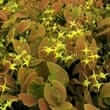Background
- The leaves of as many as 15 species of Epimedium are used as the herb known as yin yang huo in traditional Chinese medicine. "Yin yang huo" is usually translated as horny goat weed because the Chinese characters literally mean, "obscene goat leaves of pulse plants."
- In traditional Chinese medicine, Epimedium (yin yang huo) is used as a bodybuilding agent, a yang supporter, an agent to reinforce muscles and bones, and a supporter to the health of the liver and kidneys. This herb is also commonly used to treat angina pectoris (chest pain), chronic bronchitis, and neurasthenia (nervous exhaustion). As with many other herbs in Chinese medicine, horny goat weed is rarely used as a single ingredient. Horny goat weed is traditionally used as an ingredient in a yang tonic and for combating wind-damp-cold blocking qi circulation.
- Despite its traditional and popular use, there is little scientific evidence in support of horny goat weed. Currently, there exists a potential benefit for the treatment of atherosclerosis symptoms and quality of life associated with hemodialysis. Other promising areas include sexual function.
References
Natural Standard developed the above evidence-based information based on a thorough systematic review of the available scientific articles. For comprehensive information about alternative and complementary therapies on the professional level, go to . Selected references are listed below.
- Chen KM, Ge BF, Ma HP, et al. The serum of rats administered flavonoid extract from Epimedium sagittatum but not the extract itself enhances the development of rat calvarial osteoblast-like cells in vitro. Pharmazie 2004;59(1):61-64.
View Abstract - De Naeyer A, Pocock V, Milligan S, et al. Estrogenic activity of a polyphenolic extract of the leaves of Epimedium brevicornum. Fitoterapia 2005;76(1):35-40.
View Abstract - Lin CC, Ng LT, Hsu FF, et al. Cytotoxic effects of Coptis chinensis and Epimedium sagittatum extracts and their major constituents (berberine, coptisine and icariin) on hepatoma and leukaemia cell growth. Clin Exp.Pharmacol.Physiol 2004;31(1-2):65-69.
View Abstract - Liu TZ, Chen CY, Yiin SJ, et al. Molecular mechanism of cell cycle blockage of hepatoma SK-Hep-1 cells by Epimedin C through suppression of mitogen-activated protein kinase activation and increased expression of CDK inhibitors p21(Cip1) and p27(Kip1). Food Chem Toxicol. 2006;44(2):227-235.
View Abstract - Ma A, Qi S, Xu D, et al. Baohuoside-1, a novel immunosuppressive molecule, inhibits lymphocyte activation in vitro and in vivo. Transplantation 9-27-2004;78(6):831-838.
View Abstract - Meng FH, Li YB, Xiong ZL, et al. Osteoblastic proliferative activity of Epimedium brevicornum Maxim. Phytomedicine. 2005;12(3):189-193.
View Abstract - Oh MH, Houghton PJ, Whang WK, et al. Screening of Korean herbal medicines used to improve cognitive function for anti-cholinesterase activity. Phytomedicine. 2004;11(6):544-548.
View Abstract - Partin JF, Pushkin YR. Tachyarrhythmia and hypomania with horny goat weed. Psychosomatics 2004;45(6):536-537.
View Abstract - Sun Y, Fung KP, Leung PC, et al. Characterization of medicinal Epimedium species by 5S rRNA gene spacer sequencing. Planta Med 2004;70(3):287-288.
View Abstract - Wang YK, Huang ZQ. Protective effects of icariin on human umbilical vein endothelial cell injury induced by H2O2 in vitro. Pharmacol.Res 2005;52(2):174-182.
View Abstract - Wang ZQ, Lou YJ. Proliferation-stimulating effects of icaritin and desmethylicaritin in MCF-7 cells. Eur.J Pharmacol. 11-19-2004;504(3):147-153.
View Abstract - Yap SP, Shen P, Butler MS, et al. New estrogenic prenylflavone from Epimedium brevicornum inhibits the growth of breast cancer cells. Planta Med 2005;71(2):114-119.
View Abstract - Yin XX, Chen, ZQ, Dang GT, et al. [Effects of Epimedium pubescens icariine on proliferation and differentiation of human osteoblasts]. Zhongguo Zhong.Yao Za Zhi. 2005;30(4):289-291.
View Abstract - Zhang CZ, Wang SX, Zhang Y, et al. In vitro estrogenic activities of Chinese medicinal plants traditionally used for the management of menopausal symptoms. J Ethnopharmacol. 4-26-2005;98(3):295-300.
View Abstract - Zhang X, LiY, Yang X, et al. Inhibitory effect of Epimedium extract on S-adenosyl-L-homocysteine hydrolase and biomethylation. Life Sci 11-26-2005;78(2):180-186.
View Abstract







